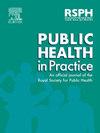The changing epidemiology of child and adolescent mental health requires an immediate policy response
IF 1.9
Q2 PUBLIC, ENVIRONMENTAL & OCCUPATIONAL HEALTH
引用次数: 0
Abstract
The epidemiology of child and adolescent mental health is rapidly evolving, necessitating urgent and coordinated responses across health, education, social services, and justice sectors. This commentary highlights key trends in adolescent mental health, emphasizing the shifting social, economic, and technological determinants shaping youth mental health. Recent evidence indicates a rise in mental health challenges, with increased gender disparities, heightened stress from academic pressures, social media exposure, and economic inequalities, among others, shaping adolescent mental health trajectories. Simultaneously, health systems are facing escalating demands for mental health care, compounded by workforce shortages and gaps in training to address emerging conditions such as digital addiction and societal withdrawal. The commentary underscores the importance of preventive, intersectoral, and life course approaches to mental health, advocating for increased investment in prevention, research, workforce development, and integrated care models. Addressing these issues requires evidence-based policies that consider cross-national differences and gendered trends while ensuring sustainable mental health systems for future generations. By prioritizing adolescent mental health within broader public health agendas, we can create a foundation for long-term well-being and social sustainability.
儿童和青少年心理健康流行病学的变化要求立即作出政策反应
儿童和青少年心理健康的流行病学正在迅速发展,需要在卫生、教育、社会服务和司法部门采取紧急和协调的应对措施。本评论强调青少年心理健康的主要趋势,强调影响青少年心理健康的不断变化的社会、经济和技术决定因素。最近的证据表明,心理健康挑战有所增加,性别差距扩大,学业压力、社交媒体曝光和经济不平等等带来的压力加剧,这些都影响着青少年的心理健康轨迹。与此同时,卫生系统面临着对精神卫生保健不断升级的需求,再加上劳动力短缺和应对数字成瘾和社会退缩等新出现疾病的培训差距。评注强调了预防性、部门间和生命全程精神卫生方法的重要性,倡导增加对预防、研究、劳动力发展和综合护理模式的投资。解决这些问题需要基于证据的政策,考虑到跨国差异和性别趋势,同时确保为子孙后代提供可持续的精神卫生系统。通过在更广泛的公共卫生议程中优先考虑青少年心理健康,我们可以为长期福祉和社会可持续性奠定基础。
本文章由计算机程序翻译,如有差异,请以英文原文为准。
求助全文
约1分钟内获得全文
求助全文

 求助内容:
求助内容: 应助结果提醒方式:
应助结果提醒方式:


